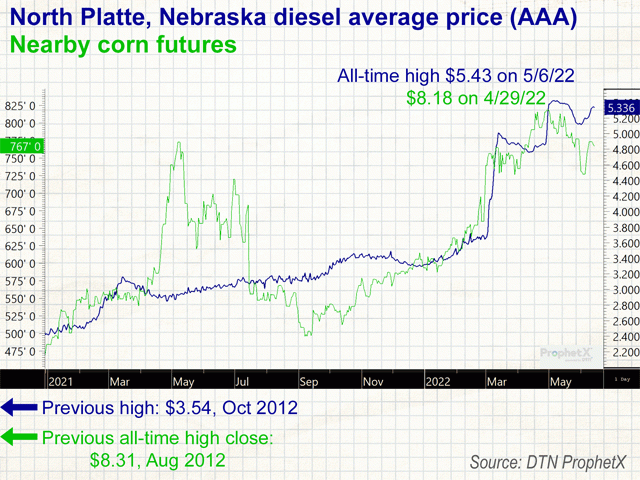Kub's Den
Fuel Up: Diesel Underpins Inflationary Pressures
The rain and sunshine are free. The land value has been agreed upon and set. The seed has been purchased and is in the ground. Even most of the fertilizer, which was previously the biggest bugbear of input cost anxiety this spring, has likely already been purchased and applied to American cornfields, with the exception of some late side-dressing or foliar applications.
Farmers may still need to purchase some herbicides or fungicides through the season, if they don't already have them on the books, but the last remaining big input cost -- the really big one -- is fuel. Fuel to drive the sprayers that apply the chemicals, possibly fuel to run the irrigation equipment, possibly fuel to run the cultivation equipment, but definitely, eventually, a lot of fuel to run all the harvesting equipment that will bring in the Northern Hemisphere's grain harvest this year.
And fuel, as everyone who's been anywhere near a gas pump lately already knows, is really expensive.
In western Nebraska, diesel costs $5.33 per gallon on June 14; in Dubuque, Iowa, it's at an all-time record high of $5.40 per gallon; in St. Louis, Missouri, it's "only" $5.27 per gallon, but this is also a record high. The national average spot price of diesel, as tracked by NYMEX, has more than doubled year over year, up 107% since last June's $2.23 price tag.
P[L1] D[0x0] M[300x250] OOP[F] ADUNIT[] T[]
Virtually every single item for sale in our modern economy is influenced in some way by the price of the diesel in the trucks that deliver these goods -- from commodities themselves, to baby formula, to replacement car parts delivered in Amazon packages -- so diesel costs, trucking costs and shipping costs are one of the primary drivers of the consumer-level inflation (8.6% for the 12 months ending in May), which will trigger the Federal Reserve to likely raise interest rates by half a percentage point (give or take 25 basis points) this week.
While grain commodity producers have little-to-no power to raise the price tags of their products just because input costs get more expensive, these more expensive input costs absolutely do affect profitability projections.
In Iowa State University's Estimated Costs of Crop Production for 2022 (https://www.extension.iastate.edu/…), variable input costs were originally assumed to be $2.62 per gallon of diesel and would have required $7.10 per acre to run a combine and $3.20 per acre to run a grain cart, or let's say about $1,650 in fuel, oil and repair costs to harvest a 160-acre field. Now that diesel is more like $5.40 per gallon, if the diesel hasn't been already bought or hedged at a lower price, variable costs for harvesting should be estimated at more like $3,400 per field.
This math is much more alarming for the farmers running diesel pivot irrigation in western Nebraska, for instance. The 2022 Nebraska Crop Budgets (https://cropwatch.unl.edu/…) originally estimated diesel would cost $2.82 per gallon this year. For a 132-acre pivot irrigation system that's fueled by diesel, it might require 31.64 total gallons of diesel fuel per acre to grow a corn crop, from spring tillage to fall trucking, but 87% of that (27.74 gallons per acre) is spent on fueling the pivot itself. That means back in a pre-Russian-war world, these farmers may have been expecting to spend about $10,300 per pivot on diesel fuel for irrigation, but now they're looking at spending $19,500 per pivot, adding an extra $0.28 per bushel to their costs of production, assuming final production of 245 bushels per acre.
Therefore, much depends on when and at what price farmers have been able to purchase diesel. When the nationwide (and global) diesel market keeps churning to fresh highs day by day, it hardly feels like the right time to be a buyer. But as DTN Farm Business Editor Katie Dehlinger pointed out last week (https://www.dtnpf.com/…), there may be opportunities for grain producers to lock in energy costs -- not only diesel for field equipment but also natural gas for grain drying needs this fall -- in the moments when the market sags.
Overall, though, we shouldn't get too hopeful about a meaningful drop in fuel prices soon. Domestic crude oil producers may be able to respond to the energy market's price signals with faster supply, but the sticking point remains U.S. fuel refineries, which have been running at a disappointing pace in recent months. Gasoline and diesel inventories are tight right as peak driving season hits. As DTN Senior Market Analyst Troy Vincent puts it: "With increasingly limited spare capacity, the potential for unplanned outages, and the outlook for an active hurricane season, we continue to believe that demand destruction rather than supply-side relief will be key to limiting inventory draws going forward."
At least the rain and sunshine are still free.
**
Comments above are for educational purposes only and are not meant as specific trade recommendations. The buying and selling of grain or grain futures or options involve substantial risk and are not suitable for everyone.
Elaine Kub, CFA is the author of "Mastering the Grain Markets: How Profits Are Really Made" and can be reached at masteringthegrainmarkets@gmail.com or on Twitter @elainekub.
(c) Copyright 2022 DTN, LLC. All rights reserved.




